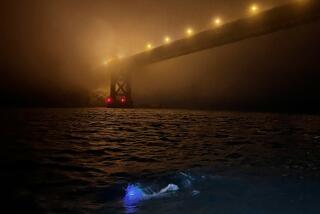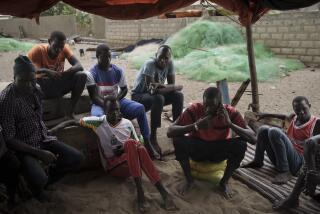She May Have Lost Her Dream, but She Escaped With Her Life : Sailing: Isabelle Autissier, who once held a 1,200-mile lead in the BOC Challenge, will be staying on land when it resumes today.
- Share via
When the gun goes off today, 15 sailors will leave behind Sydney’s famed harbor and set a course for Punta del Este, a resort in Uruguay 6,900 miles and perhaps a dozen squalls to the east.
But the woman who once held a 1,200-mile lead over her nearest rival won’t be one of them.
This time, Isabelle Autissier will be staying on land.
Thus begins the third leg of The BOC Challenge, a four-stage, 27,000-mile solo race around the world that started Sept. 17 in Charleston, S.C.
To say the race is grueling is to say it’s kind of tough to win a Super Bowl. Yeah, that’s true.
First run in 1982, the race is held once every four years. It takes about eight months to compete, a month to recover, and more than three years to raise the $100,000 to $2.5 million needed to outfit a 40- to 60-foot boat for such a punishing trip.
And sometimes, all the money
and technology in the world is not enough. Two of the 20 boats entered in this race--two high-tech racing machines--have already gone down.
In the first leg from Charleston to Cape Town, South Africa, a boat piloted by Josh Hall of Britain sank after hitting a submerged object in the middle of the south Atlantic. After several frantic hours, Hall scrambled into his lifeboat and was pulled from an angry ocean by Alan Nebauer of Australia, a fellow competitor.
In the latest life-and-death struggle with the sea, Autissier was winched off her badly damaged yacht by an Australian Navy helicopter four days after setting off a distress beacon.
To this day, the Frenchwoman will not speak of her emotions upon leaving her $770,000 boat 750 nautical miles southwest of Adelaide, Australia, on Jan. 1.
The boat was never seen again.
But that gets ahead of the story.
Autissier, 38, didn’t enter the race as the favorite, but she came with some mighty fine credentials.
A sailor since age 7, she finished seventh in her class in the last BOC Challenge, in 1990-91.
Then, last April, she smashed the New York-to-San Francisco speed record around Cape Horn by an astonishing 14 days, despite suffering through nearly a week of no wind and being washed overboard by a wave.
Sailing in the “Ecureuil Poitou-Charentes 2,” the same boat she used for this BOC Challenge, Autissier and a three-man crew made the legendary passage in 62 days, 5 hours, 55 minutes.
“I am very proud to be the winner of this record, and that’s enough,” she told reporters who pressed her on how she felt to be the first woman to hold the record.
Five months later, as the only woman competing in The BOC, she repeated that theme.
“Women can do it just like men,” she said. “It’s not my purpose to prove anything.”
To quote Shakespeare, “The lady doth protest too much.” The marine science professor from La Rochelle, France, was definitely out to prove something. She entered to win, not place.
“You try to push yourself as hard as you can and you try to push your boat,” Autissier explained before taking off from Charleston. “But you must not push too hard, because if you push too hard you will break something. It’s very important to know the balance.”
The best small boat racers detect minute wind and current changes over a finite area. Those who race around the world, though, need to understand wind, weather and currents on a vast scale.
A little meteorology helps. Autissier studied weather patterns for a year before the race, and used that knowledge to flatten her competitors in the first leg.
She also rolled the dice--and was the only sailor to head east and north after the starting gun.
From a tactical standpoint, the 6,870-mile first leg from Charleston to Cape Town is the trickiest of four. Sailors must skirt the high pressure weather system around Bermuda, tack upwind against the Atlantic trade winds, cross the treacherous doldrums, avoid the calms near Saint Helena and try to roar home on the heavy winds of the south Atlantic.
Any questions?
Sailors who chose a contrarian path--go out on a flyer, in non-nautical terms--do not end up in the middle of the pack. They win big or they are humiliated.
Autissier won. By two days or 1,200 miles, take your pick.
While others were running 3 to 4 knots, she was averaging 9. While they stalled for at least four days around Bermuda, she was slowed for only 12 hours. While they struggled out of the doldrums on Oct. 8, she had been gone for at least three days.
“I managed to drive into a big Atlantic parking lot and had a hard time finding an exit,” Steve Pettengill, the skipper of “Hunter’s Child” from Middletown, R.I., moaned to race control.
By Saint Helena, a weather window opened and shut. While Autissier was able to slip by and reach Cape Town on Oct. 23, the winds picked up and blocked her rivals farther behind.
“Isabelle hit every waypoint spot on--and turned the fan off as she went by,” said fellow racer David Adams of Australia.
The feat turned Autissier into a heroine in France. But there remained three legs--nearly 20,000 miles--to be sailed.
“I will try to sail the same way,” she said. “Anything can happen with so many miles to go.”
Anything is right.
On the second leg, the 6,700-mile run from Cape Town to Sydney, it wasn’t the first dismasting that defeated Autissier, and it wasn’t the second.
It was the monster wave that rolled her 60-foot yacht like a tub toy, smashing a 15-foot hole in her cabin roof, punching through a rear compartment and wiping out her steering system.
The French sailor first ran into trouble Dec. 2, when a stay broke and her 83-foot mast toppled over. The nearest land was 1,100 miles to the east, in the Kerguelen Islands.
Using a 25-foot spinnaker pole as a mast, Autissier jury-rigged a sail and spent 10 tedious days heading to those specks of land in the frigid south Indian Ocean. On Dec. 17, she finally rejoined the race with two smaller masts--the best her team could come up with on such short notice.
They stood up to winds of the “Furious Fifties” for a mere 11 days.
In a stroke of luck, Autissier was below decks when she heard the ominous roar of a huge wave. She had already taken down every sail, but the 50-knot winds still pushed her yacht forward in the churning seas.
Then it hit.
“If I had been on the deck, I would have been washed away,” Autissier told race officials later.
Once the boat righted itself, she set off two emergency radio beacons, and hurried to block more water from pouring in.
It was Dec. 28. She didn’t know it yet, but she had four long, chilly days to wait before an Australian frigate, the HMAS Darwin, would arrive. Four days to reflect that her dream was over. Four days to make sure another wave didn’t do her in.
“Sad and cold,” she commented in a Dec. 31 radio message.
Pictures of Autissier dangling in the air on a helicopter line, her boat wallowing beneath her, were sent around the world on New Year’s Day.
“I am here because of you, and I will never forget that,” she told the Seahawk crew after her rescue.
L’Equipe, the French sports daily, devoted its entire back page to her rescue, under a bold headline: “Autissier: I was never afraid.”
Despite her bravado, the ordeal took a toll. Autissier fled the spotlight after the search for her boat was abandoned, taking a week-long vacation along Australia’s southeast coast.
But the race--like life--goes on.
Defending champion Christophe Auguin of France won the second leg and holds a 38-hour lead over the American, Pettengill, in the Class I 50- to 60-foot boats.
Adams, the Australian sailor, leads the Class II category of 40-to 50-foot yachts by about 22 hours over Italy’s Giovanni Soldini.
Repaired and restocked, all leave knowing that the worst--rounding South America’s dreaded Cape Horn--is yet to come.
And Autissier, who lost her dream but escaped with her life, will see them off.
More to Read
Sign up for The Wild
We’ll help you find the best places to hike, bike and run, as well as the perfect silent spots for meditation and yoga.
You may occasionally receive promotional content from the Los Angeles Times.






